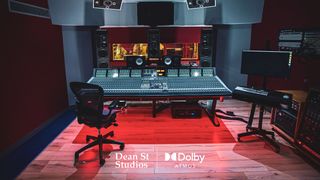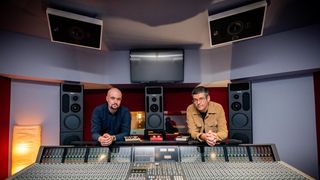For more than six decades we've enjoyed stereo music reproduction, even though several surround formats have threatened to replace it. But now Dolby Atmos is yet another contender, bringing, as it does, the technology of cinematic immersion to music enjoyment - and the best bit is you can enjoy the experience on home systems.
One of the first recording facilities in the UK to invest in the tech is Soho's Dean St Studios - where music icons like David Bowie, Adele, John Legend, Lady Gaga and Ed Sheeran have recorded, so we went along to find out more.
What is Dolby Atmos?
You have almost certainly come across Dolby Atmos technology from visits to the cinema, experiencing the immersive results from a multi-speaker playback system that enables you to enjoy dynamic sound all around you.
You are also probably aware that domestic systems - soundbars, binaural headphones and so on - enable you to replicate the experience at home, by way of an increasing number of content providers including Disney+, Netflix and Apple TV.
However, what you may not know is that Dolby Atmos Music is the relatively new incarnation of the technology that could revolutionise the way we consume and enjoy music. It is being heralded as the replacement for stereo that we’ve all been waiting for, and leading London recording studio Dean St. Studios is among the first major facilities to invest in it.
“We’ve been waiting for a replacement for stereo for decades,” says Jan 'Stan' Kybert, the engineer responsible for installing the Dean St. Studios facility. “It’s an ancient technology. With music you want to feel something, like with a Saturday night or Sunday morning record. They make me feel ‘Saturday night’ or ‘Sunday morning’. That feeling has been lost with stereo now, and it’s not stereo’s fault, but with Dolby Atmos that feeling is there. It’s bigger, more exciting and wants to make you move, be more intimate, more relaxed or whatever. Everything it does it does it on a richer level.”

So how does Dolby Atmos actually work?
On a technical level, where stereo audio is limited to two channels of output, Atmos offers 128 discrete locations to send audio, which can move and alter at the mixer's requirements, utilising a connection to a supported DAW (Pro Tools, Logic, Ableton). While like 5.1 or 7.1 it uses a surrounding array of speakers for mixing, it doesn't suffer from the former's required numbers of speakers , and as a medium is adaptable to any system with Atmos technology installed.
“It is so much more”, says Stan. “You might have a forward-facing Dolby Atmos mix - drums, bass and vocal - coming at you and then you'll maybe use the Atmos technology to wrap an orchestra around the listener. Or you have extra width. With stereo there is this trend to use wideners but with Atmos it can be as wide as you ever need it and as tall as you ever want it.
“The tools that Atmos gives me in height, width, depth and sub are everything you need in comparison to stereo. In stereo you are always making sacrifices when mixing, like if you want to hear the guitar you may have to turn the Hammond down. You are constantly having to make decisions and carve out EQs in consideration of what other instrumentation is playing. You don’t need to do that in Atmos as there is enough space for everybody. The music is so dynamic, and it is such a joy to experience.”
And Stan should know about mixing. He's spent more than two decades in the recording industry, serving as Mark 'Spike' Stent's Pro Tools engineer and Oasis's in-house engineer at Wheeler End Studios in Buckinghamshire. He helped Spike record the Mancunians' Standing On The Shoulder Of Giants album in the south of France, and is a long-time collaborator with Paul Weller. His connections with Dean St Studios go back to that time at Wheeler End, then owned by current Dean St Studios' directors Jasmin Lee and Suzanne Lee-Barnes.
“I spent four or five years working with Spike on all sorts of records - Bjork, Massive Attack, Spice Girls, S Club 7 - quite a wide range,” he explains, “and then with Oasis it was more recording and I stayed at Wheeler End for a long time until the band split, really. That’s when Jazz and Suzanne started considering another venture, and they’ve now been running Dean St Studios for over a decade.
“We had been talking about doing various things at Dean St Studios. Suzanne has been in the industry for years and identified the Atmos trend within the industry, so when those discussions started, they came to me to help install it.”
As it happens, Stan was already involved with the technology through his work with Paul Weller: “At the beginning of lockdown I got a phone call about approving some Atmos mixes for Paul Weller for the number one album On Sunset which I'd originally mixed. Then, the very same week, Jazz and Suzanne called to ask me about Atmos asking what I knew about it, and I said ‘funnily enough I have this project…’”
Stan set to work with the Dolby team and PMC who provided the speaker array: “I got huge support from Dolby and PMC who are integral to the project. And once those pieces were in place, hearing it just confirmed it. It was that lightbulb moment of ‘oh, this is going to supersede stereo’.”
Atmos for all
The system installed at Dean St. Studios is what Stan describes as “a world-class PMC 9.1.4 setup”. It features PMC’s IB2S XBD-A active monitors for the left and right main channels, a PMC IB2S-A monitor for the centre channel, 10 discrete Wafer2 loudspeakers for surround and height channels and four sub2 subwoofers. With such a setup, not only do listeners to Atmos mixes experience full immersion, but for mix engineers, it takes a lot of the strain out of mixing for different playback systems, as Stan explains.
Atmos for music is actually a dynamic format so when I create an Atmos mix, it will adapt to the device that it is playing on.
“As a stereo mixer, what keeps me awake at night is how my mixes are going to translate on someone’s headphones, in a club, on the kitchen radio or on a very nice pair of Focal home hi-fi speakers. I have one mix that has to serve all platforms. Atmos for music is actually a dynamic format so when I create an Atmos mix, it will adapt to the device that it is playing on. Play it on your Sonos Soundbar which is 5.1.2, and it will optimise to play on that device. Play it on your Sennheiser 660 headphones and you’ll get the binaural mix and so on.”
“And the way we’re creating the mixes is different,” he continues. “Atmos is a space, but it’s not all about sounding like a Marvel film, although it can be - maybe EDM suits that kind of movement and creativity within the Atmos space, but that’s just one genre of music. All the many others are more suited towards taller, wider, richer, deeper experiences. And domestically it’s different because you don’t need a Blu-ray; you stream it and the tech is already in hundreds of millions of homes. People have soundbars that are Atmos enabled, the Echo Studio from Amazon is awesome and Atmos enabled, and binaural headphones handle it.”
With such flexibility in the mix process the possibilities for Atmos mixing are many and varied, including bringing the live experience - currently such a rarity thanks to the pandemic - to our homes.
“Every mix is about emotion and intention,” says Stan. “Atmos mixing means it is so much more accessible to convey what an intention is so, yes, with a live mix, we can put you at the gig and I have done one and people were like, ‘it’s like being there’. But it’s not just about 'bigger'; if you have a guitar and a voice it’s about being more intimate; if it’s slamming EDM we can make the drop shake your bones and it translates domestically. Previously other formats weren’t fully understood and you were asked to try them alongside stereo whereas here the tech is in the homes. It’s definitely going to supersede stereo.”




